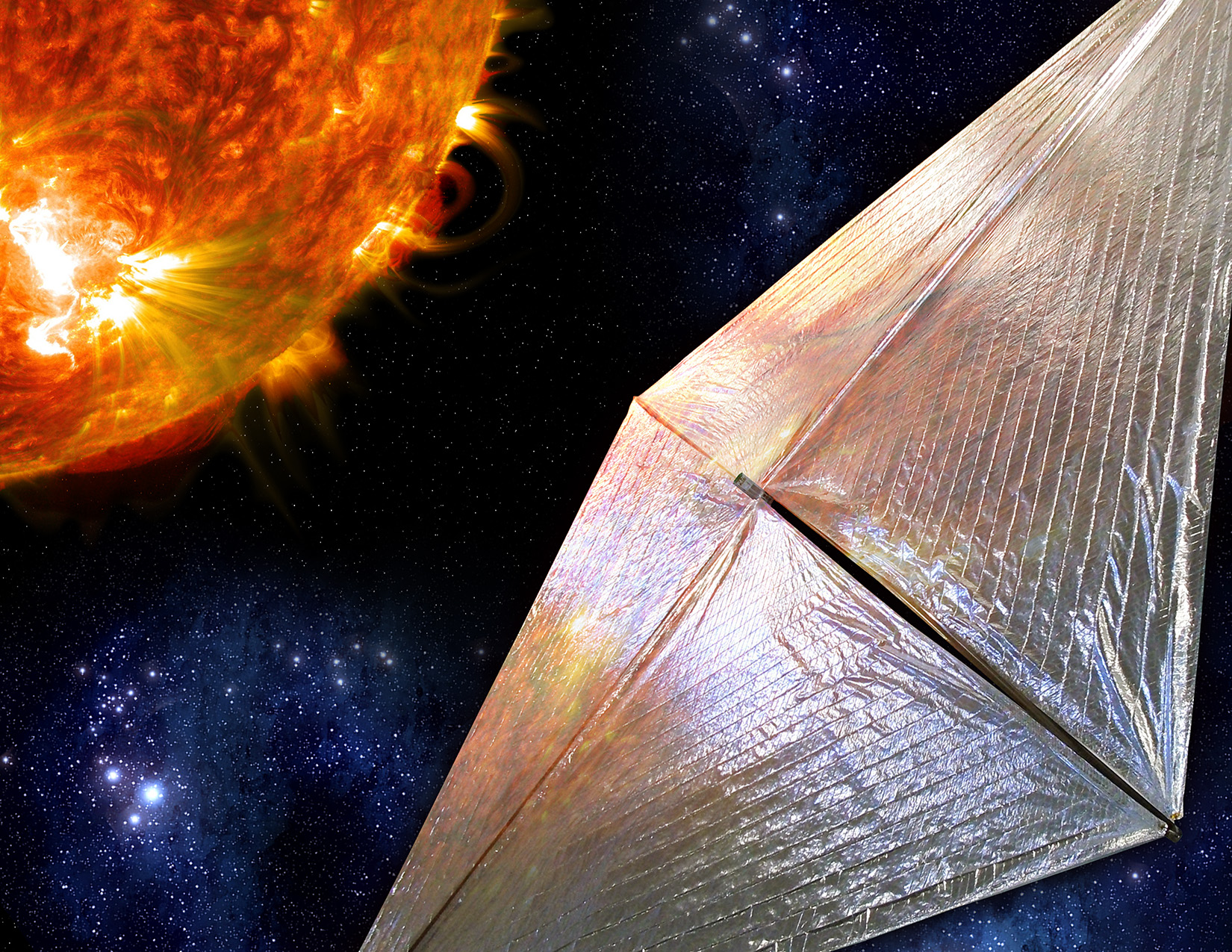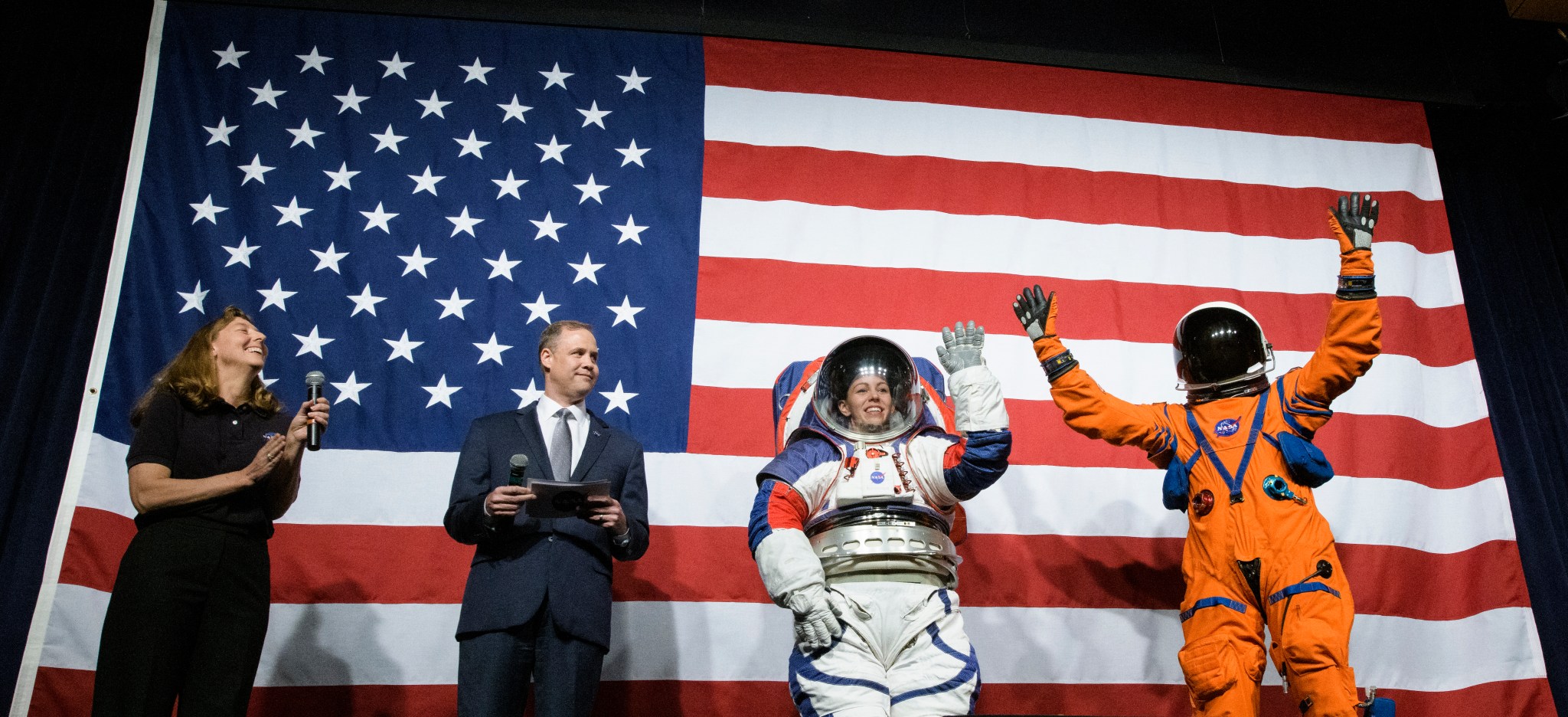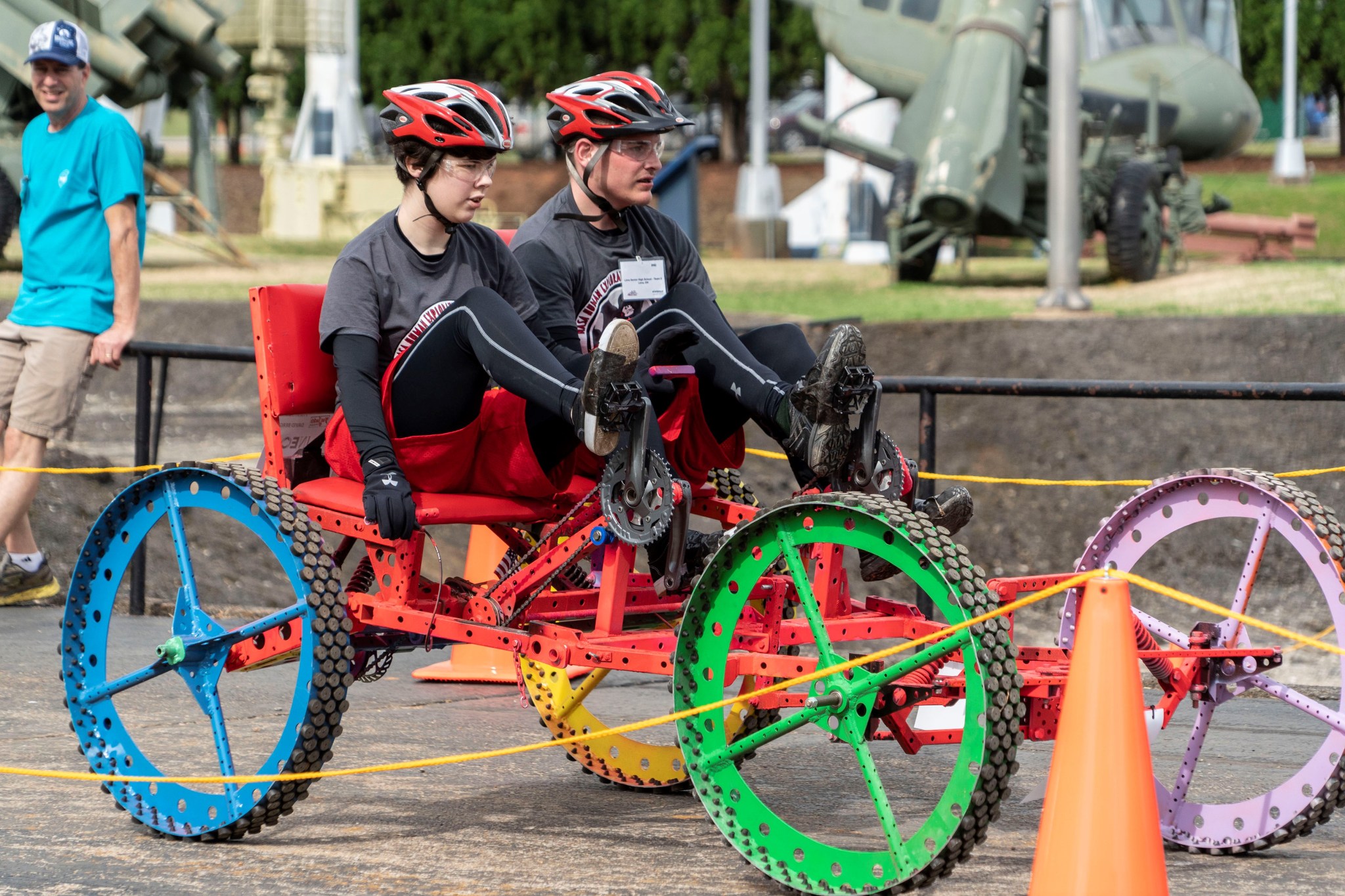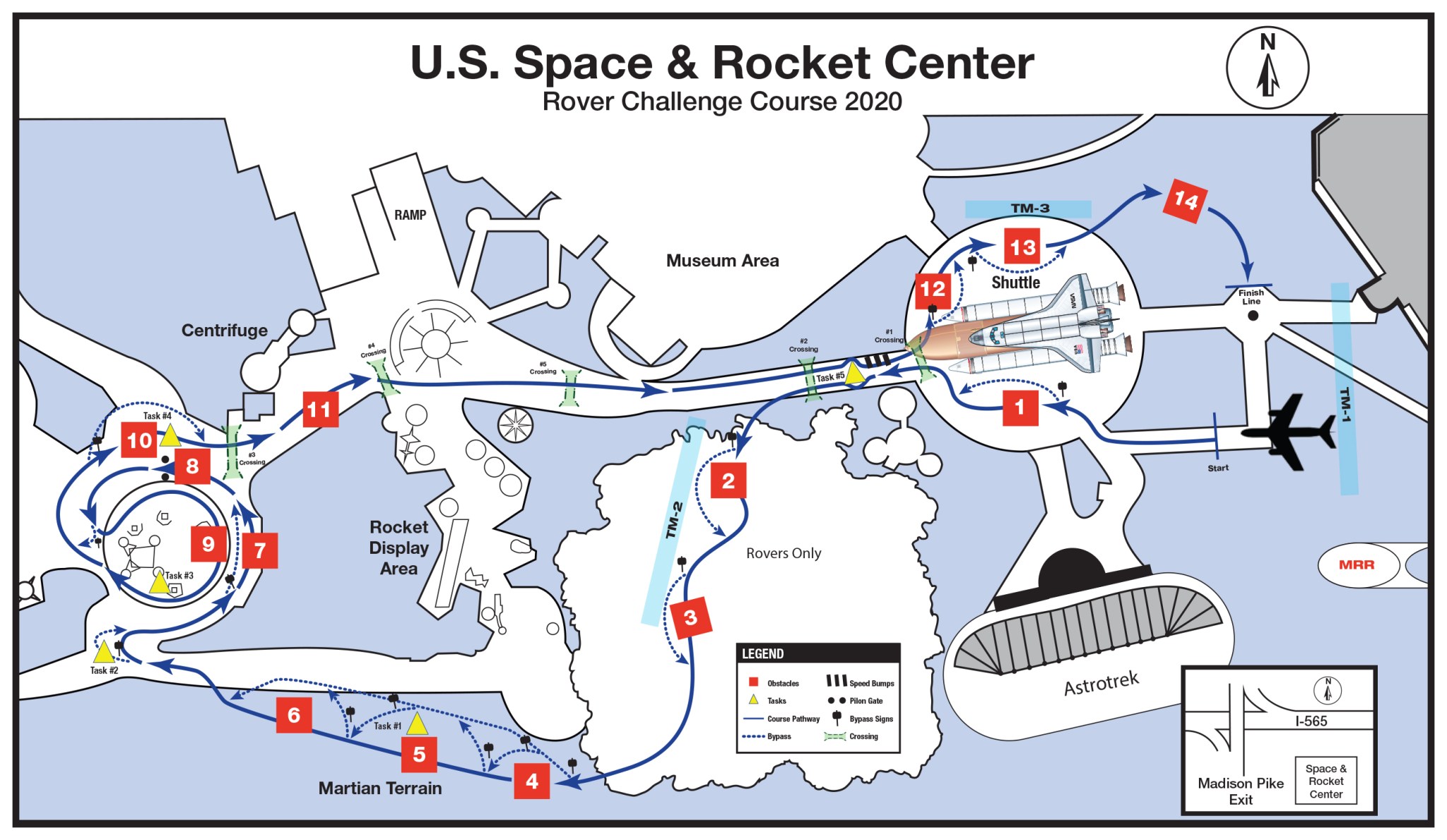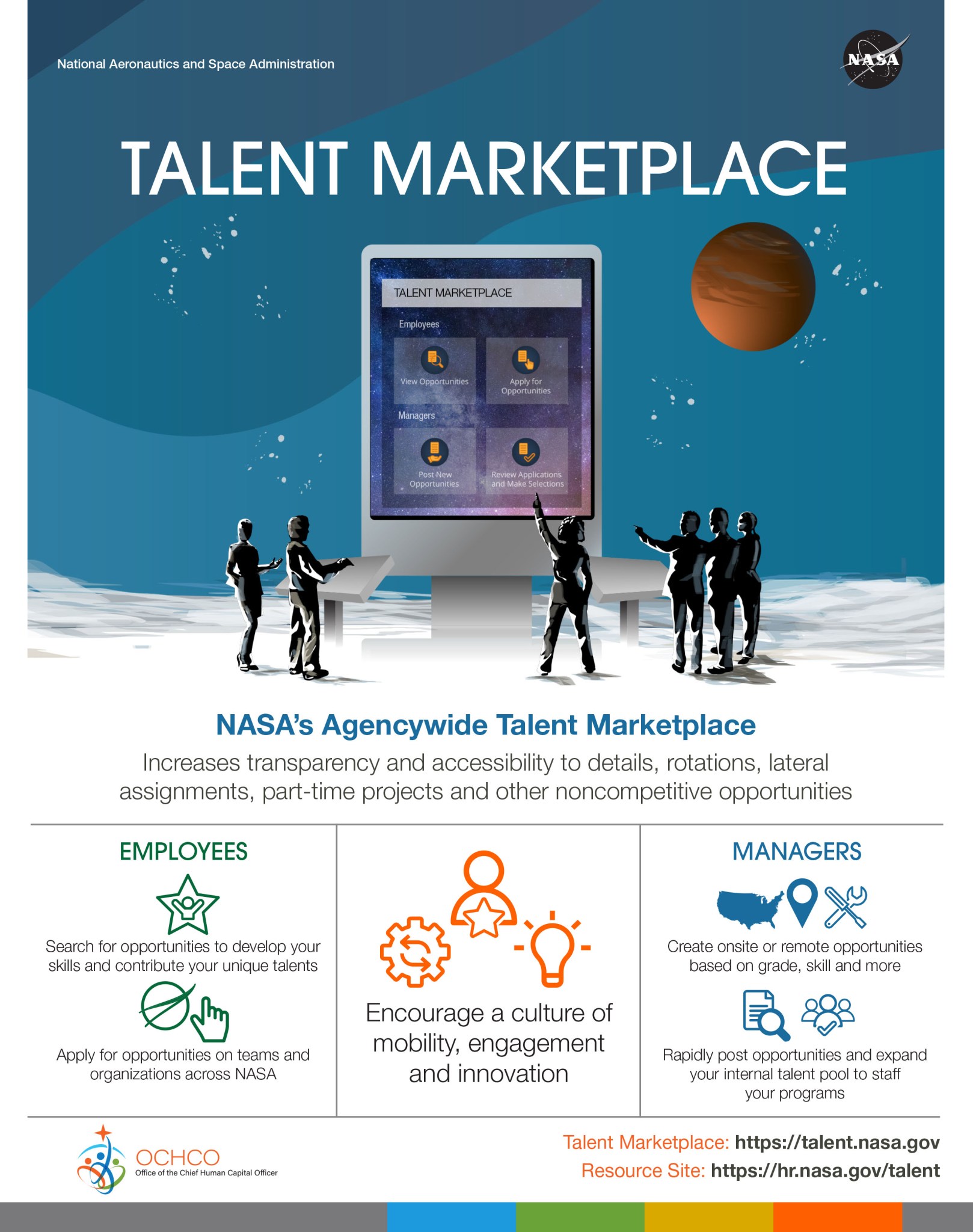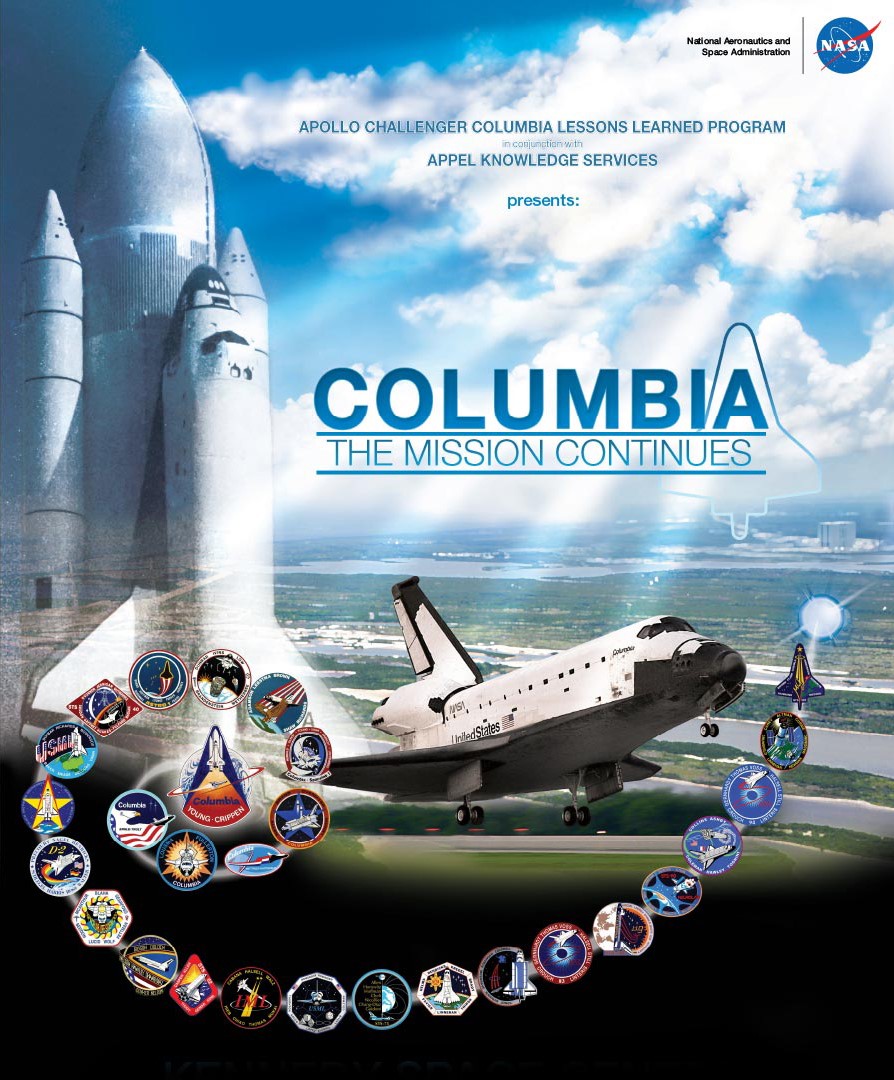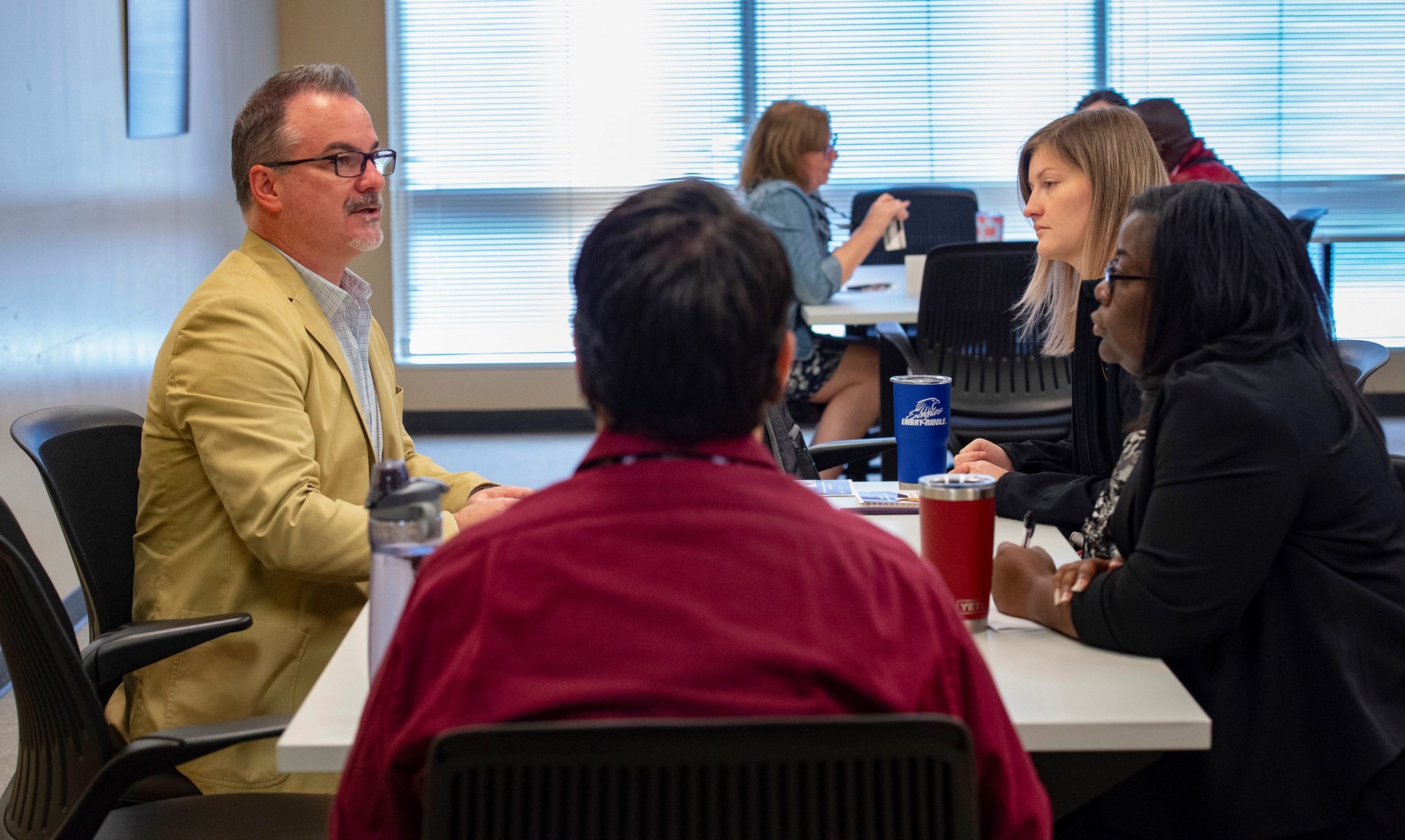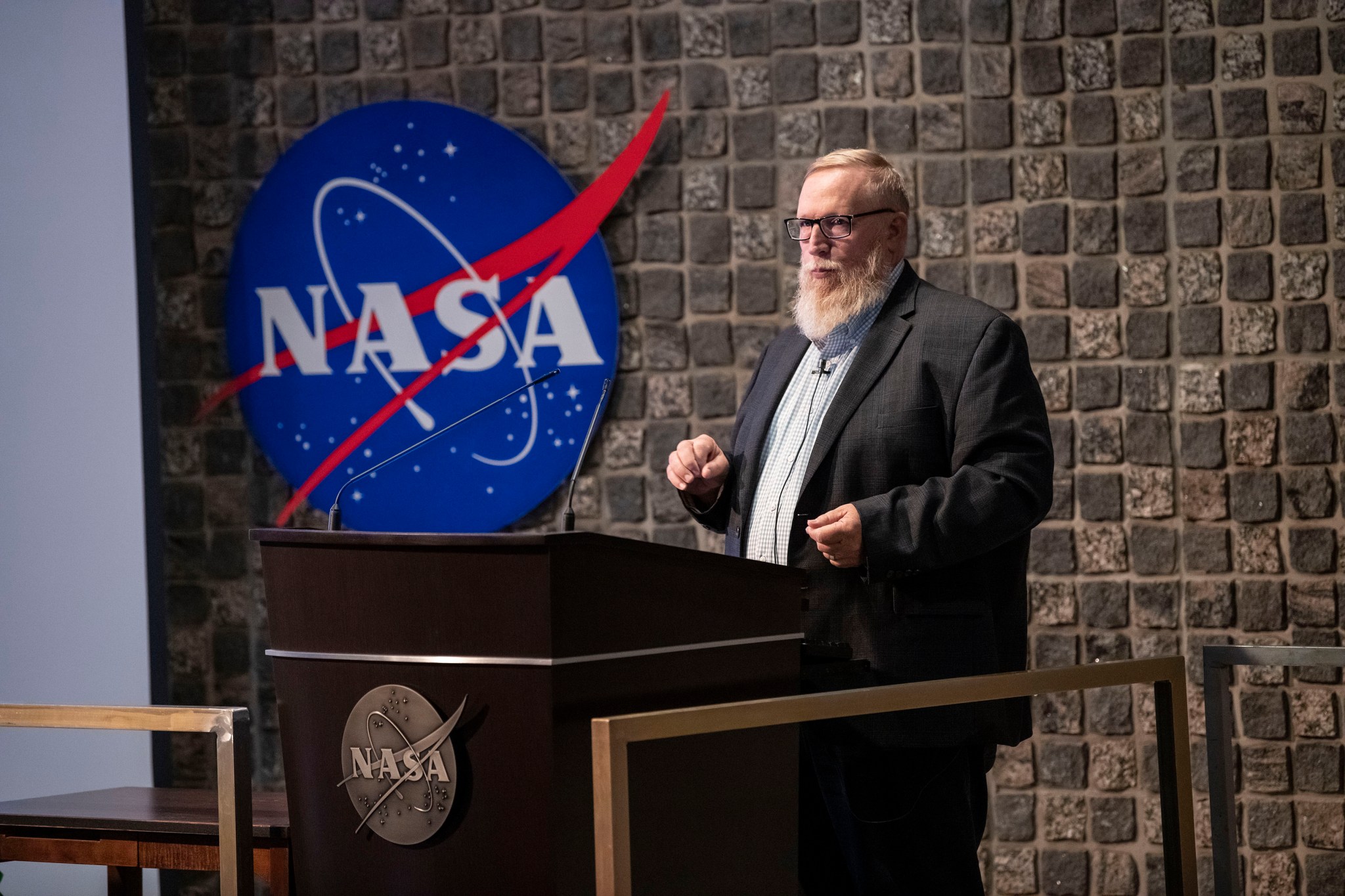In This Week’s Star
- Proposed Solar Cruiser Could Advance Sun Exploration, Improve Space Storm Warning Systems
- Expedition 61 Crewmember Completes Spacewalk, Shares Mission with Redstone General
- Rocket Science in 60 Seconds: What Are the SLS Rocket Avionics?
- NASA Unveils Next Generation Spacesuits for Artemis Missions
- NASA Opens Registration for 2020 Human Exploration Rover Challenge
- NASA’s Agencywide Talent Marketplace Now Available for Civil Servants
- Space Shuttle Columbia National Tour and Decision Management Course Coming to Marshall
- Marshall Leaders Offer Guidance, Support at Change-Themed Mentoring Event
- Safe In Your Space: Marshall Hosts Annual Safety Day
Proposed Solar Cruiser Could Advance Sun Exploration, Improve Space Storm Warning Systems
By Daniel Boyette
When Les Johnson was in high school during the 1970s, a science fiction novel titled “The Mote in God’s Eye” captured his imagination. He was particularly fascinated by the element of an alien race using solar sails to travel through space.
“I remember reading that story and it was the coolest thing,” said Johnson, now a physicist at NASA’s Marshall Space Flight Center.
Fast forward to the present, and solar sails — which move by gaining momentum transferred by reflecting photons — are anything but a work of fiction. Johnson is the solar sail principal investigator for the Near-Earth Asteroid Scout, a CubeSat that will fly on Artemis I. He is also the principal investigator for the Solar Cruiser, one of two proposals recently selected by NASA to vie for an opportunity to launch as a secondary payload with NASA’s Interstellar Mapping and Acceleration Probe spacecraft in October 2024.
“What we’re proposing is probably one of the most exciting technologies that NASA has tried to do since the ‘60s,” Johnson said. “We know what sails can do. What’s gratifying is that the technology has matured to the point that we can actually do something with it.”
Solar Cruiser, a chair-sized small sat, would use the same sail material as NEA Scout — an incredibly thin plastic, coated with aluminum. Solar Cruiser would feature a nearly 18,000-square-foot sail, 19 times larger than the sail used by NEA Scout.
“Propelling solar sails with sunlight is sort of like playing pool — the cue ball hits another ball and knocks it away,” Johnson said. “Photons are like little cue balls that hit the sail. It’s a very small push, but over time, that adds up to a lot of velocity.”
It is hoped that the selected proposal for the IMAP mission – the other finalist being the Science-Enabling Technologies for Heliophysics, a proposal from NASA’s Goddard Space Flight Center — will demonstrate small satellite technologies to improve science observations in deep space. Each was funded $400,000 by NASA’s Heliophysics Solar Terrestrial Probes program for nine-month mission concept studies.
The Solar Cruiser investigation would demonstrate two technologies. First, the use of a solar sail that would show the ability to use solar radiation as a propulsion system, which could provide views of the Sun not easily accessible with current technology. For example, a solar sail can slowly change the orbital inclination of a spacecraft from roughly equatorial, the vantage point we have from the Earth, to polar, which is extremely difficult to accomplish due to the large amount of energy required — but it is something a solar sail could excel at doing.
The Solar Cruiser would also carry a coronagraph instrument, which images the Sun’s outer atmosphere — the corona — by blocking out the much brighter disk of the Sun’s surface, making an artificial “solar eclipse.” The coronagraph would map out the magnetic structure of the corona, detect waves that carry energy out into the solar wind and measure the size and speed of coronal mass ejections — giant explosions of solar material that are expelled into space at speeds exceeding 1 million miles per hour. These ejections, filled with charged particles and relatively strong magnetic fields, can trigger space weather storms capable of damaging satellites above the Earth, and utility grids on the ground. Solar Cruiser would demonstrate important technology for improving advance warning systems for at-risk infrastructure on and above the Earth.
“You can also use a solar sail to take a solar storm warning satellite closer to the Sun to increase the warning time of impending storm headed toward the Earth,” Johnson said. “These storms travel slower than the speed of light. So, if you detect the storm, you can radio home and give warning. Ultimately, we can double the warning time. With the sail, we can go closer to the Sun and, instead of drifting away, which a normal spacecraft would do, we can thrust to stay there all the time.”
As for the future, Johnson envisions solar sails five to 10 times larger the one used by Solar Cruiser, which could send a robotic probe out of the solar system, as a possible successor to Voyager.
“Solar Cruiser is going to demonstrate the capability that NASA needs to go do these really cool missions,” he said. “Missions that no other propulsion system can do.”
Boyette, an ASRC Federal/Analytical Services employee and Marshall Star editor, supports the Office of Strategic Analysis & Communications.
Expedition 61 Crew Member Completes Spacewalk, Shares Mission with Redstone General
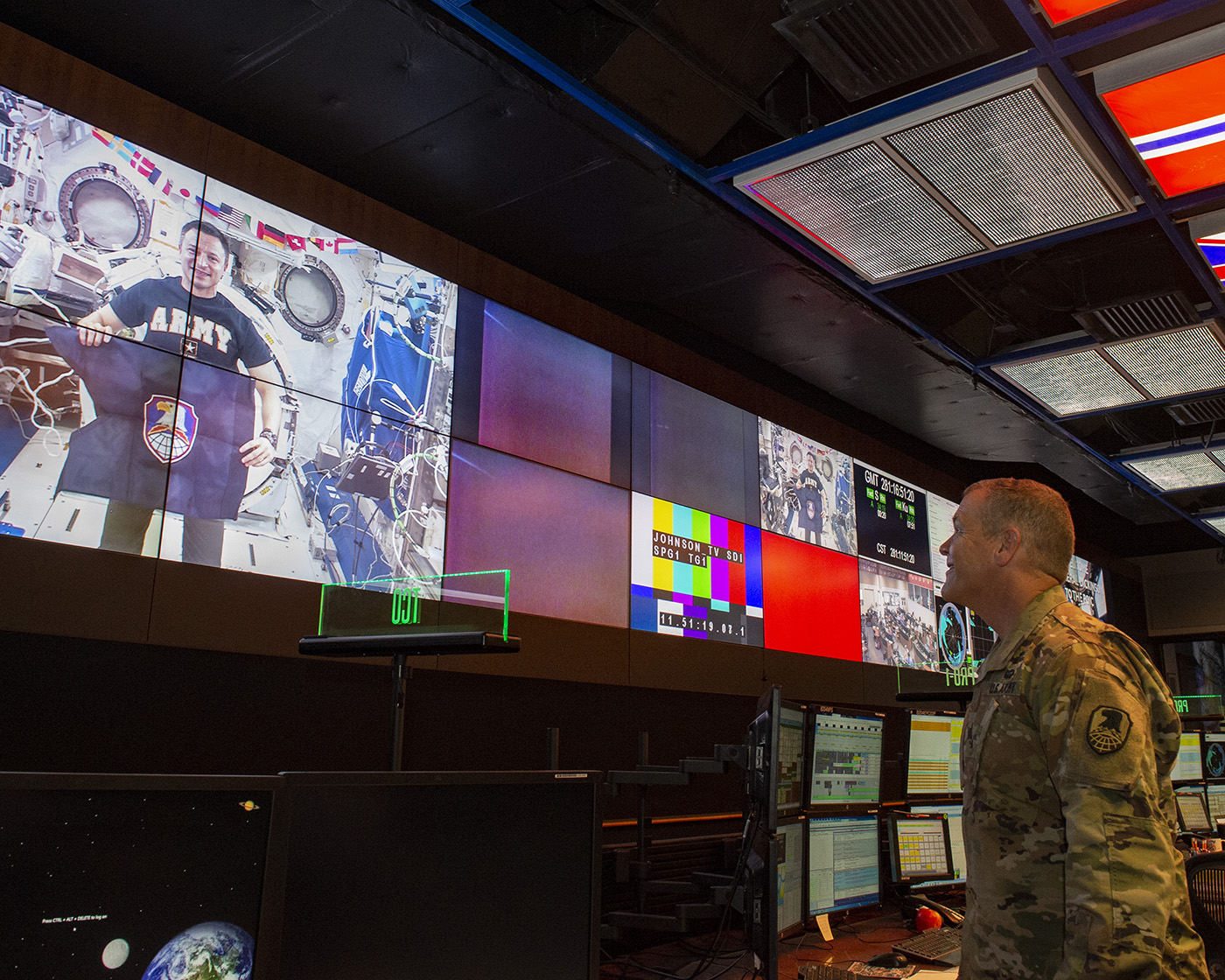
Army Lt. Gen. James Dickinson, right, commanding general of the U.S. Army Space and Missile Defense Command, speaks with NASA astronaut and current International Space Station crew member Andrew Morgan, an Army colonel, during an Oct. 8 downlink to the Payload Operations Integration Center at NASA’s Marshall Space Flight Center. Morgan, an active-duty emergency physician, answered the call two days after completing a seven-hour spacewalk. He reported on the beauty of Earth from space, the camaraderie of the Expedition 61 crew and how his military background prepared him for the mission. Space station managers postponed three spacewalks previously scheduled for this and next week to install new batteries in order to first replace a faulty battery charge/discharge unit. The BCDU failed to activate after Morgan and fellow flight engineer Christina Koch installed new lithium-ion batteries on the station’s truss during an Oct. 11 spacewalk. After upgrading the batteries — which store power generated by the station’s solar arrays to provide power to the station when it is not in the sunlight — the crew will focus on repairs to the space station’s Alpha Magnetic Spectrometer with five additional spacewalks. All of the U.S. segment crewmembers who will be in space during that time – Morgan, Koch, Jessica Meir and the European Space Agency’s Luca Parmitano — are expected to participate. If successful, this two-part series may set a record pace of 10 spacewalks during the next three months — a cadence that has not been experienced since assembly of the space station was completed in 2011. (NASA/Emmett Given)
Rocket Science in 60 Seconds: What Are the SLS Rocket Avionics?
Rocket Science in 60 Seconds gives you an inside look at work being done at NASA to explore deep space. Alex Matras is a software developer for NASA’s Space Launch System rocket at NASA’s Marshall Space Flight Center. In this episode, join Matras inside the SLS rocket’s Systems Integration Lab as he explains how the rocket’s flight computers and avionics help steer, fly, track and guide the powerful rocket through launch and flight to the Moon. For more information about SLS, click here.
NASA Unveils Next Generation Spacesuits for Artemis Missions
At first glance, NASA’s new spacesuit that will be worn on Artemis missions might look like the suits that astronauts use for spacewalks outside the International Space Station today. However, 21st century moonwalkers will be able to accomplish much more complex tasks than their predecessors
The new suit that will be worn on Artemis missions — the Exploration Extravehicular Mobility Unit — has a suite of dust-tolerant features to prevent inhalation or contamination of the suit’s life support system or other spacecraft. The suit also is built to withstand temperature extremes of minus 250 degrees Fahrenheit in the shade and up to 250 degrees in the sun.
The Portable Life Support System is the familiar backpack astronauts wear on spacewalks that houses the suit’s power and breathable air and removes exhaled carbon dioxide and other toxic gasses, odors and moisture from the suit. It also helps regulate temperature and monitors overall suit performance, emitting warnings if resources fall low, or if there is a system failure. Miniaturization of electronics and plumbing systems have made it possible to build in duplicates for much of the system, making some failures less of a concern. The duplication also increases safety and could increase spacewalk durations.
The new lower torso includes advanced materials and joint bearings that allow bending and rotating at the hips, increased bending at the knees, and hiking-style boots with flexible soles. The lower torso will be modified from the current suit to accommodate mobility in partial gravity, because astronauts floating in space don’t need to use their legs or feet nearly as much as those walking or driving a rover on a planetary surface.
A new feature on the improved suit design is the rear-entry hatch. Astronauts will be able to climb into a spacesuit from the back of the suit, which allows the shoulder elements of the hard upper torso to be closer together than the suits currently in use. The improved shoulder placement increases mobility and enables a better fit while also reducing the risk of shoulder injuries. Other shoulder enhancements allow astronauts to move their arms more freely and easily lift objects over their heads or reach across their body in the pressurized suit. The new shoulders minimize the effort required for full mobility and include bearings that allow full rotation of the arm from shoulder to wrist.
Inside the helmet, NASA has redesigned the communications system. The new audio system includes multiple, embedded, voice-activated microphones inside the upper torso that automatically pick up the astronaut’s voice when they speak to their fellow spacewalker, their crewmates aboard the Gateway or mission control in Houston. The helmet will also feature a quick-swap protective visor. The clear protective visor is a sacrificial shield that protects the pressurized bubble from any wear and tear or dents and scratches from the abrasive dirt of planetary bodies. The quick-swap function means that astronauts can replace the visor before or after a spacewalk instead of sending an entire helmet back to Earth for repairs.
The new suit is designed with interchangeable parts that can be configured for spacewalks in microgravity or on a planetary surface. The same core system could be used for the International Space Station, the Gateway in lunar orbit, the Moon or Mars.
When astronauts are hours away from launching on Artemis missions to the Moon, they’ll put on a brightly colored orange spacesuit called the Orion Crew Survival System suit. It is designed for a custom fit and equipped with safety technology and mobility features to help protect astronauts on launch day, in emergency situations, high-risk parts of missions near the Moon and during the high-speed return to Earth.
The Orion suit has been enhanced with improvements to the suit worn on shuttle missions. The helmet is lighter, stronger, comes in more than one size, helps reduce noise and is easier to connect to the communications system. The outer cover layer includes shoulder enhancements for better reach and is fire resistant. The suit is a pressure garment that includes a restraint layer to control the shape and ease astronauts’ movements. A reengineered zipper also allows astronauts to quickly put the suit on and has increased strength. New adaptable interfaces supply air and remove exhaled carbon dioxide. The suit has and improved thermal management that will help keep astronauts cool and dry. A liquid cooling garment, worn underneath the suit, a bit like thermal underwear with embedded cooling tubes, was revamped to be more breathable and easier to build.
NASA Opens Registration for 2020 Human Exploration Rover Challenge
By Daniel Boyette
Registration has opened for student teams to participate in the 2020 NASA Human Exploration Rover Challenge, set for April 17-18, 2020, at the U.S. Space & Rocket Center. Registration for international teams closes Dec. 12; U.S. team registration ends Jan. 16, 2020.
The 26th edition of the annual event, managed by the Office of STEM Engagement at NASA’s Marshall Space Flight Center, features students from high schools, colleges and universities around the world designing, engineering and testing a human-powered rover to take on a course simulating terrain found on the Moon and Mars, as well as other planets, moons and asteroids.
“Rover Challenge is a showcase for members of the Artemis generation, who combine ingenuity with their knowledge of the science, technology, engineering and math fields to tackle the course,” said Julie Clift, an education program specialist at Marshall.
Rover Challenge reflects the goals of NASA’s Artemis Program, which seeks to put the first woman and next man on the Moon by 2024. One female and one male driver will pilot each team’s lightweight rover across the grueling half-mile course featuring obstacles and scientific challenges.
The contest previously focused on finishing the course as quickly as possible. Now, its primary mission is to challenge teams to think like NASA mission planners and planetary explorers. Among the rule changes for the 2020 challenge is the addition of one minute — for a total of eight minutes — to finish the course, which gives teams a greater opportunity to earn points by completing more of the optional 14 obstacles and five science tasks.
The tasks in this year’s competition are:
1. Spectrographic Analysis — Take photographs with a camera using different filters.
2. Instrument Deployment — Deploy a solar powered cell for a scientific instrument.
3. Core Sample Retrieval — Collect a sample consisting of loose rock or mineral grains bound together by a liquid.
4. Solid Soil Sample Retrieval — Collect, bag and store solid surface samples.
5. Liquid Sample Retrieval — Collect, bag and store three separate liquid samples.
In another major rule change, NASA will no longer accept pneumatic tires or other commercially purchased wheels on any competing vehicle. Each team must design and fabricate their wheels — with the exception of the central hubs. The 2020 Technology Challenge award will focus on wheel design and fabrication. Judging will be evaluated on a written report, oral interview, presentation, wheel inspection and performance of the technical solution during the race.
NASA’s Office of STEM Engagement furthers the agency’s goal of encouraging students to pursue degrees and careers in the STEM fields through multiple challenges, including Rover Challenge.
For questions regarding U.S. and international team registration, please contact MSFC-RoverChallenge@mail.nasa.gov.
Boyette, an ASRC Federal/Analytical Services employee and Marshall Star editor, supports the Office of Strategic Analysis & Communications.
NASA’s Agencywide Talent Marketplace Now Available for Civil Servants
By Adam Farragut
On Sept. 30, NASA launched the agency wide Talent Marketplace, a platform that allows civil servants to find and apply to noncompetitive opportunities from across the agency. These opportunities include internal details, short-term or part-time assignments, leadership programs and lateral reassignments.
USAJobs will still be used for competitive opportunities.
The platform is designed to give employees access to a wider range of opportunities while giving managers the flexibility to tap into all of the agency’s internal talent resources. The goal is that it will ultimately enhance the culture of employee mobility, engagement and innovation that is required to achieve the NASA mission.
“In the past, these opportunities have largely been offered through word-of-mouth and networking, which can be limiting,” said June Malone, acting manager of the Services Office in Marshall’s Office of Human Resources. “The new system not only opens up the process for employees, but for managers looking to fill positions as well.”
Thirteen opportunities already have been posted on the marketplace in the brief time since its launch, with numbers expected to rise as the workforce becomes more familiar with the platform.
Civil servants are encouraged to explore the Talent Marketplace, set up automatic alerts to receive notice of new opportunities and to apply their expertise to advance the NASA mission.
For information and support, visit the Talent Marketplace resource site.
Farragut, an ASRC Federal/Analytical Services employee, supports Marshall’s Office of Strategic Analysis & Communications.
Space Shuttle Columbia National Tour and Decision Management Course Coming to Marshall
By Will Bryan
The Space Shuttle Columbia National Tour is coming to NASA’s Marshall Space Flight Center from Nov. 5-8.
Prior to the tour, the APPEL Knowledge Services’ Complex Decision Making in Project Management course will be taught Oct. 30-31. The goal of the two-day course is to provide multiple opportunities for participants to gain experience in complex decision making and critical thinking through group discussions and examination of lessons learned from relevant case studies.
On Nov. 5, The Space Shuttle Columbia National Tour exhibit will open in Marshall’s Building 4221 lobby, and a town hall in Building 4316 will kick off a week of activities to discuss technical authority and risk management. The exhibit displays pieces of Columbia recovered after the accident in 2003.
There will be a lunch and learn Nov. 6 and 7 from 11:30 a.m. to 1 p.m. The first, titled “Risk Leadership and Lessons Learned from Columbia” and hosted by Marshall’s Safety and Mission Assurance Directorate, will be in Room 1103 of Building 4221. The second, a case study on Columbia, titled “After Math: Foamology and Flight Rationale” and hosted by Marshall’s Chief Knowledge Integrator Jennifer Stevens, will be in Room 1201 of Building 4203.
Using the lessons learned from the loss of Columbia, the discussions will help both Marshall’s veteran and early career engineers, leaders and workforce understand what happened in order to help prevent another accident from occurring. Panel discussions and lunch and learns will affirm to Marshall’s workforce the importance of listening to all concerns in the decision-making process.
The path to the Moon and Mars goes through Marshall, making it crucial that the team understands and is prepared to handle complex decisions where mission success and lives are on the line. Using the lessons learned from Columbia, as well as Challenger and Apollo 1, the week of discussions will help ensure that the missions undertaken now and in future stand the best possible chance of being successful.
Information about the week’s activities will be posted on ExplorNet.
Bryan, an ASRC Federal/Analytical Services employee, supports the Office of Strategic Analysis & Communications.
Marshall Leaders Offer Guidance, Support at Change-Themed Mentoring Event
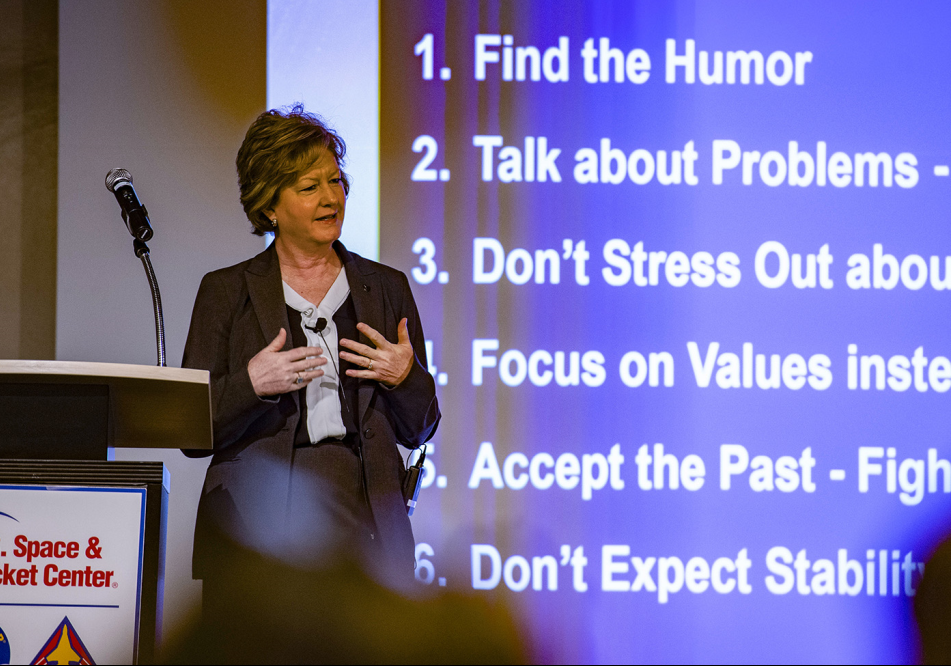
Lisha Adams, executive deputy to the commanding general of the U.S. Army Materiel Command, delivers the keynote address at NASA Marshall Space Flight Center’s mentoring event, “Change: It Happens,” Oct. 10 at Marshall’s Education Training Facility. More than 100 Marshall team members attended the event, which featured group mentoring panels with Marshall leaders, speed mentoring opportunities and guidance on living and working well in a changing environment. Mentors included Marshall Deputy Center Director Paul McConnaughey, Office of Diversity & Equal Opportunity Director Loucious Hires and Human Exploration Development and Operations Office Manager Bobby Watkins. (NASA/Emmett Given)
Davey Jones, left, Integration & Development lead for the Environmental Control and Life Support System at Marshall, works with a small group at the “Change: It Happens” mentoring event Oct. 10 at Marshall’s Education Training Facility. (NASA/Emmett Given)
Safe In Your Space: Marshall Hosts Annual Safety Day
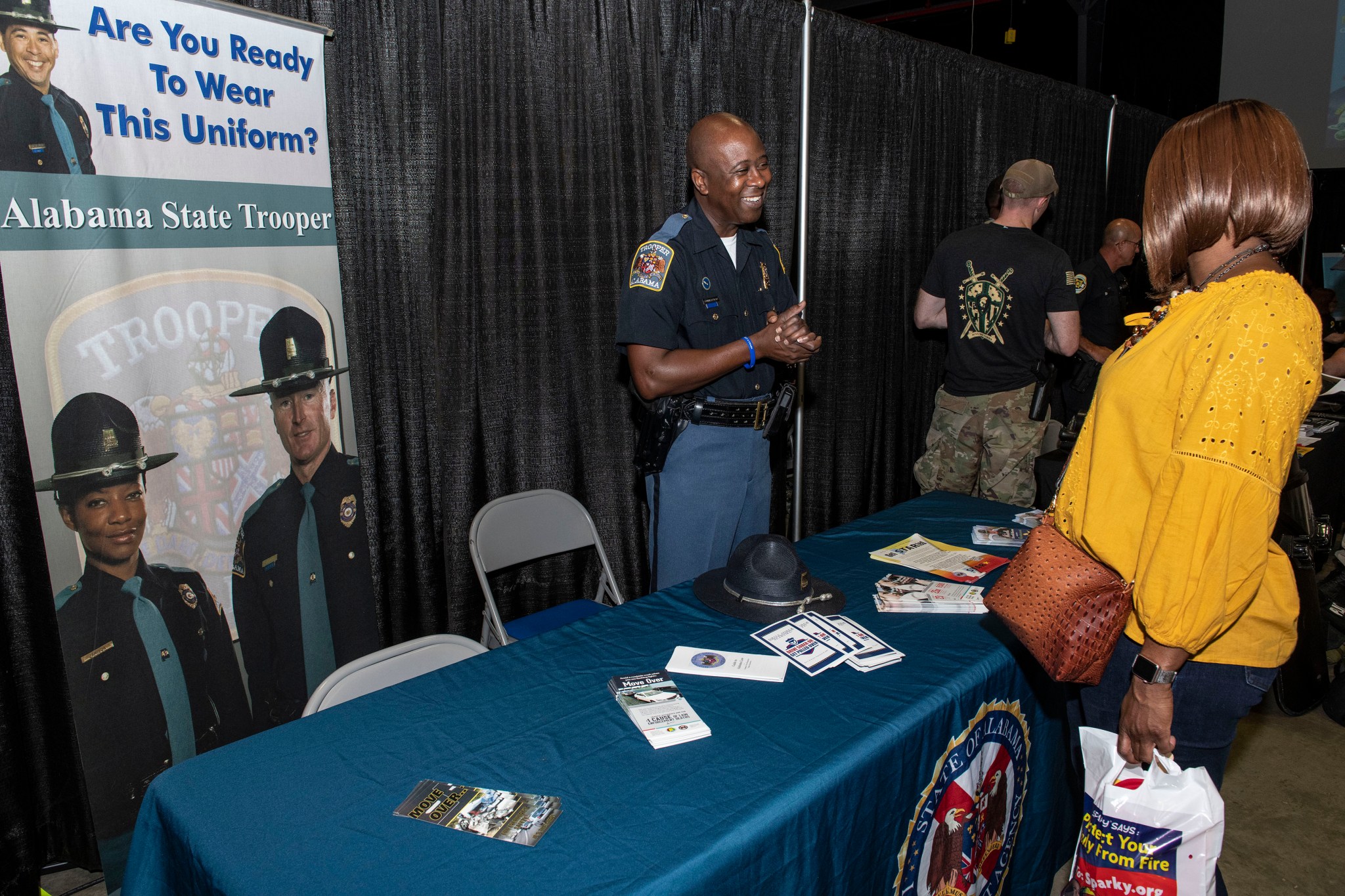
The Alabama State Troopers were among organizations taking part in the vendor fair during Safety Day on Oct. 2 at NASA’s Marshall Space Flight Center. This year’s theme was “Safe in Your Space.” Approximately 1,200 team members participated in a variety of events, including the vendor fair, incident- and injury-free workshops, a safety-themed game of “Wheel of Fortune” and Zumba and yoga classes. Free food was available during the vendor fair, courtesy of Bastion Technologies Inc. and Jacobs. (NASA/Fred Deaton)
Gerry Schumann, NASA’s Mishap Investigation Program executive, opens Safety Day with a keynote address on workplace and personal safety. (NASA/Fred Deaton)





























